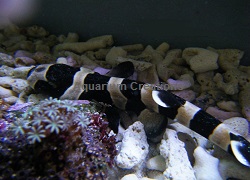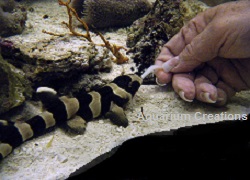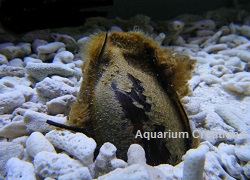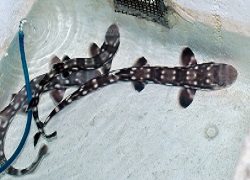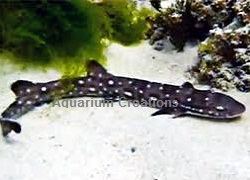Short Tail Nurse Shark
Captive Bred by ORA
Pseudoginglymostoma brevicaudatum
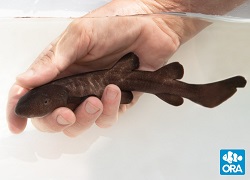
Description:
The ORA Captive Bred Short-tail Nurse Shark is a tremendous accomplishment of ORA's Marine Aquaculture Farm. The Short-Tail NurseShark is the smallest member of the nurse shark family. With a maximum reported length of just 30 inches they are considerably shorter than any other species of sharks we raise. With their small size and low activity, these are one of the best species of sharks for a large home aquarium. This little-known inshore bottom shark occurs on the continental and insular shelves of East Africa and Madagascar. They are well-adapted to life on the coral reefs with a tough skin that is advantageous when navigating in and around rough coral reef structures. Like all other sharks, they are nocturnal. The Short Tail Nurse Shark is an oviparous species, which simply means they are an egg laying species, with a birthing time of 165 days to hatch! Another interesting tid bit of the Short-Tail Nurse Shark is they can remain out of water for several hours and still be fine. Their common name refers to the unique feature of their precaudal tail being shorter than head and body length and a petite caudal fin less than a quarter of their total length. These sharks have a broad and blunt shaped head with very small eyes and tiny nasal barbels.
Tank Recommendations
The ORA Captive Bred Short-tail Nurse Shark requires a minimum aquarium size of 200 gallons. They readily adjust to aquarium confines. A bottom dwelling species, they can do well under the care of the experienced shark keeper. It requires a soft sand bottom as the substrate as the belly can easily be scratched by coarser substrate, which may lead to an infection. Like all sharks, it can never be exposed to copper-based medications. Like most sharks the Short-tail Nurse Shark is a nocturnal species that inhabits waters where less light is present, therefore they are light sensitive. Typically it stays hidden in an aquarium while the bright lights are on, and therefore should be provided with an adequately sized cave or light-sheltered space where it can hide. A better remedy is to simply have more subdued lighting for the shark tank and you will find your sharks will be out and about more.
Food and Diet:
The ORA Captive-Bred Short Tail Nurse Shark has a hearty appetite and its best to feed when they are naturally most active, that being around dawn and dusk. If the Shark is roaming around the aquarium during daytime hours, its not being curius, it means it needs to be fed more food. Even though the Short-Tail Nurse Sharks are captive Bred we do not suggest hand feeding them. It's a foolhardy activity! Offer meaty foods including pieces of fresh shrimp, scallop, mysis shrimp, and/or marine fish flesh. When first introduced into the aquarium we have found pieces of cleaned squid or live saltwater feeder shrimp can be used to entice the ORA Captive-Bred Short Tail Nurse Shark to eat. Once feeing add fresh shrimp, scallops or pieces of fresh marine fish.
Reef Compatability:
No
Level of Care:
Difficult
Acclimation time:
4+ hours
Approximate Purchase Size:
5" to 8"
Interesting Notes:
They are a long-lived shark, The Artis Royal Zoo in Amsterdam kept a female Short-tail Nurse Shark for over 33 years and it was the first to reproduce in captivity.
They like to rest on their sides or even upside down for extended periods. We were warned about this with our first pair but it takes a while for the panic to wear off when you see them like that.
Their eggs take an incredible 165 days to hatch!
Short-tail Nurse Shark $1975.00
Short-tail Nurse Shark Pair $3995.00
|
|
Speckled Carpet Shark,
Captive Bred by ORA
Hemiscyllium trispeculare
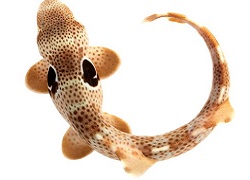
Description:
Speckled Carpet Sharks (Hemiscyllium trispeculare) are a smaller shark species originally native to northern Australia and New Guinea. Fascinating to observe, the Speckled Carpet Shark uses its pectoral and pelvis fins to walk along the substrate with a wiggling type motion. Its shape and size are similar to the Epaulette Shark (Hemiscyllium ocellatum) with a long body, small round paired pectoral and pelvic fins and a maximum reported size of only 30 inches. The pattern of the Speckled Carpet Shark consists of densely spaced, fine spots covering their entire head and body. Overall color is tan with dark brown saddles composed of darker clusters of spots. Their characteristic ocelli or epaulettes are well defined and bordered by a white halo and a dark patch to the posterior.
Speckled Carpet Sharks are most active at night and typically remain stationary under a shelter during the day. Rather than constantly swimming around the tank, they are bottom dwellers that may swim in short bursts but they prefer to walk around on their paired fins. In nature they exhibit this behavior walking between tide pools as they hunt for their preferred prey items: small fish, crustaceans, cephalopods, mollusks and polychaete worms. Speckled Carpet Sharks will only eat food that will fit in their mouth, they don’t tear up prey in the traditional shark sense. Rather, they need bite sized pieces of food which they chew thoroughly before swallowing.
Tank Recommendations
We consider the Speckled Carpet Shark to be an animal for an experienced aquarist. They must be provided with a low stress environment with limited disruption, an easy to consume diet with multivitamin supplementation and excellent water quality. Despite their relatively small size and relaxed disposition, a full-sized Speckled Carpet Shark will need to be housed in a tank with a minimum size of 200 gallons and carefully chosen tank mates. We strongly urge anyone looking to keep a shark to thoroughly research the species prior to purchase. This is a long-term commitment!
Food and Diet:
ORA® Speckled Carpet Shark pups are sold by us only after they will eat well a diet of frozen large mysis shrimp, chopped squid, shrimp and salmon.
Reef Compatability:
No
Level of Care:
Difficult
Acclimation time:
3+ hours
Approximate Purchase Size:
6" to 8"
$799.99
|
|
Captive Bred Epaulette Sharks
Hemiscyllium ocellatum
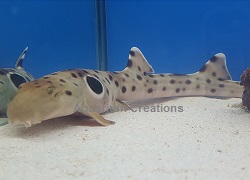
Video of Saltwater Aquarium with Epaulette Shark
Description:
Our Captive Bred Epaulette Sharks have been lovingly hatched and raised from their egg. We hand feed them small pieces of fresh squid, shrimp, and other crustaceans every other day. Because of this, they are more accustomed to human contact than wild-caught Marbled Cat Sharks, and they are comfortable with tank life. You can feed yours by hand, as well. Just be sure to cut up the pieces small enough as pieces that are too big may get spat back out. Many of our hand fed Marbled Cat Sharks are so comfortable with people that you can pet them. But never forget that they are sharks, and you should still be cautious and alert when handling and caring for them.
The Epaulette Shark, Hemiscyllium ocellatum, is a beautiful spotted pattern and a characteristic pair of large spots above their pectoral fins. This conspicuous marking resembles the shoulder décor used on military uniforms to signify rank, lending the "epaulette" term to their common name. The Captive-Bred Epaulette Shark does grow quickly but will only reach about 30" in the home aquarium, making them an excellent choice for advanced aquarists looking to keep a real nice shark. Native to the shallow reefs of Northern Australia and New Guinea, this shark species has evolved extraordinary adaptations to survive the harsh, fluctuating environment of tide pools and coral flats. As the tide goes out and isolated pools of water form, the Epaulette shark exploits their confines as easy hunting grounds. In a motion similar to land based amphibians, Epaulettes can use their paired pectoral and pelvic fins as arms and legs to maneuver around coral and rock formations. They can also tolerate high temperatures and very low oxygen levels as exposed tide pools become increasingly more inhospitable.
Tank Recommendations
We consider the Epaulette Shark to be for the very experienced aquarist They must be provided with a low stress environment with limited disruption, an easy to consume diet with multivitamin supplementation and excellent water quality. Despite their relative small size and relaxed disposition, a full sized Epaulette will need to be housed in a tank with a minimum size of 200 gallons and carefully chosen tank mates. It requires a soft sand bottom as the substrate as the belly can easily be scratched by coarser substrate, which may lead to an infection. Like all sharks, it can never be exposed to copper-based medications.
Food and Diet:
When first introduced tiny pieces of squid work best. Once feeding feed a more varied diet consisting of vitamin enriched chunks of meaty foods including krill, raw table shrimp, squid, clam and mussel.
Reef Compatability:
No
Level of Care:
Difficult
Acclimation time:
3+ hours
Approximate Purchase Size:
Small 5" to 7",Medium 7" to 9" "
Small Female $699.99
Small Male $769.99
Medium Female $799.99
Medium Male $869.99
|
|

